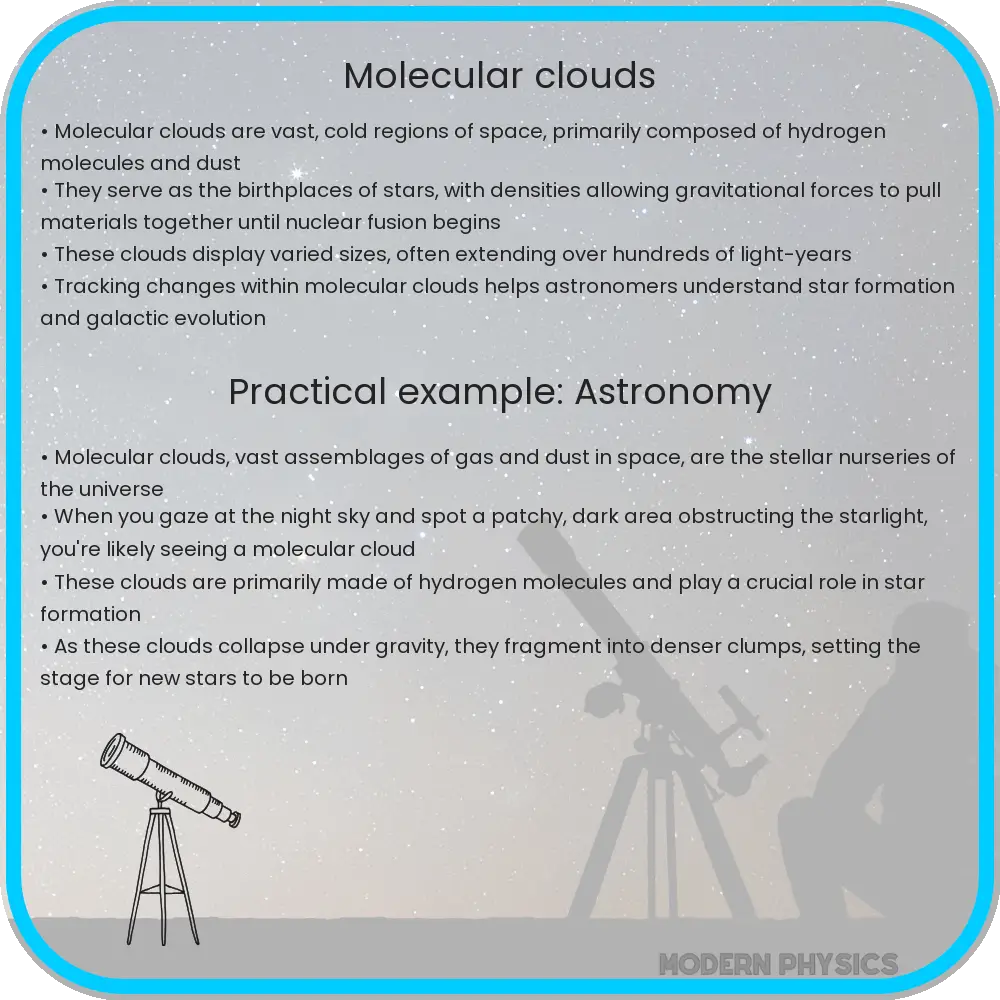Explore the formation, composition, and significance of molecular clouds in astrophysics, the birthplaces of stars and crucial to understanding the universe.

Molecular Clouds: Formation and Composition
Molecular clouds, also known as stellar nurseries, are pivotal in the cosmic tableau, serving as the principal sites for star formation. These vast, dense areas of gas and dust in interstellar space are primarily composed of molecular hydrogen (H2), with traces of helium and other elements. This composition makes them significantly cooler and denser than other interstellar regions, setting the stage for the birth of new stars.
Formation of Molecular Clouds
The formation of molecular clouds is a complex process influenced by the dynamics of the interstellar medium (ISM). Typically, these clouds form in the spiral arms of galaxies where matter is more concentrated. Several mechanisms contribute to their formation, including the compression of interstellar gas by shock waves from supernovae, collisions between different gas clouds, and the gravitational instability within the galactic disk. Once the gas density reaches a critical threshold, molecular hydrogen forms, predominantly through the attachment of free hydrogen atoms onto the surfaces of cosmic dust grains, shielded from the destructive ultraviolet radiation by the dust itself.
Composition of Molecular Clouds
Molecular clouds are not just homogenous masses of hydrogen. They contain a diverse mix of molecular gases, dust, and complex organic compounds. Besides molecular hydrogen, carbon monoxide (CO) is the second most abundant molecule, serving as a crucial tracer for astronomers to map and study these clouds, due to its strong emission lines. Other molecules, such as water (H2O), ammonia (NH3), and methane (CH4), are also present, albeit in smaller quantities. The dust particles, composed mainly of silicates and carbon-based compounds, play a vital role in the thermal balance and chemistry of the clouds, aiding in the cooling processes necessary for star formation.
The intricate interplay of physical and chemical processes within molecular clouds is essential for the condensation of matter into denser regions, leading to the eventual collapse under gravity and the birth of new stars. This cycle of star formation and death enriches the interstellar medium with heavier elements, contributing to the chemical evolution of the galaxy.
Molecular Clouds: Formation, Composition, and Role in Astrophysics
Molecular clouds, also known as stellar nurseries, are pivotal regions in the universe where new stars are born. These dense areas of gas and dust are primarily found in the spiral arms of galaxies and play a crucial role in the life cycle of stars. Understanding the formation, composition, and significance of molecular clouds offers insights into the processes that shape galaxies and the universe at large.
Formation of Molecular Clouds
The formation of molecular clouds is a complex process influenced by various factors including the gravitational collapse of gas in the interstellar medium, interactions between different gas flows, and the effects of magnetic fields. When regions within giant molecular clouds become unstable, they begin to collapse under their own gravity, leading to the formation of smaller, denser molecular clouds. These clouds continue to accumulate mass, eventually leading to the birth of new stars.
Composition of Molecular Clouds
Molecular clouds are predominantly composed of molecular hydrogen (H2) and helium, with trace amounts of other molecules such as carbon monoxide (CO), water (H2O), and ammonia (NH3). The presence of dust particles, which absorb and scatter ultraviolet radiation, helps to shield these delicate molecules from the harsh environment of space, allowing them to survive and contribute to the cloud’s density and thermal properties.
Role in Astrophysics
Molecular clouds play a critical role in the field of astrophysics. They are the primary sites of star formation and significantly influence the dynamics and evolution of galaxies. The processes that occur within these clouds, such as the collapse of gas to form stars and the subsequent feedback from young stars, are fundamental to understanding the lifecycle of stars and the chemical enrichment of the universe. Additionally, studying molecular clouds helps astronomers trace the distribution of matter in galaxies and understand the conditions necessary for star and planet formation.
Conclusion
Molecular clouds are essential components of the cosmos, acting as the cradles of star formation. Their complex structures and composition are integral to the fabric of the universe, influencing the evolution of galaxies and the distribution of chemical elements. By studying these celestial phenomena, scientists can uncover the mysteries of stellar evolution, galaxy formation, and the intricate processes that drive the cosmic lifecycle. As we continue to explore the vastness of space, molecular clouds remain at the heart of our quest to understand the universe and our place within it.
